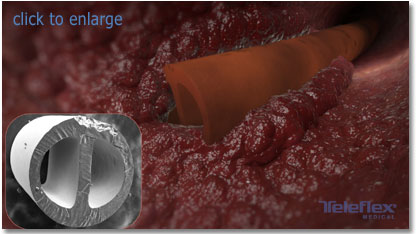| First Section Page | Page 12 of 13 | Last Section Page |
POST-INSERTION RELATED COMPLICATIONS
Thrombosis
Catheter-related thrombosis is due to vessel trauma, hypercoagulation of blood or stasis. Placing a catheter into a vessel that is too small to allow adequate blood flow, is stenosed in any area or has evidence of prior clot formation may contribute to the formation of a catheter-related thrombosis. Other contributing factors to catheter-related thrombosis include traumatic insertions, stiff catheter material, large catheters or malpositioned catheter tips. Thrombosis development within 24-48 hours may be the direct result of bacterial contamination during the insertion procedure, resulting in a thrombophlebotic reaction to the bacteria. The risk of clots is lowest in the subclavian vein, followed by the internal jugular and femoral veins ().
Symptoms of thrombosis include:
- Swelling of ipsilateral extremity
- Swelling at the insertion site
- Unexplained fever
- Discoloration or edema distal to the thrombus
- Pain in the jaw, shoulder or ear
- Resistance to flushing or flow may decrease
Be aware that a majority of patients who have thrombosis are asymptomatic.
Prevention/Management
Perform a detailed patient assessment prior to insertion noting patient risk factors. Use ultrasound and perform a complete assessment of patient vasculature to evaluate vein health and size prior to selecting an access site ().
If there is unusual edema, investigate the site with ultrasound and initiate anticoagulation if a clot is found ().
Caution: Take extreme precautions when removing a CVC from a thrombosed vessel ().
